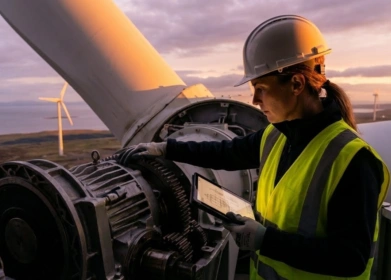How Long Does an Aerospace Engineering Degree Take?
Explore how long it takes to earn an aerospace engineering degree. Learn about the duration of Bachelor’s, Master’s, and Ph.D. programs to plan your educational path.
Jennifer Sheriff

If you're considering a career in aerospace engineering, one of the key factors you'll need to evaluate is the duration of the required education. Aerospace engineering is a challenging and rewarding field that combines principles of physics, mathematics, and engineering to design and develop aircraft, spacecraft, and related systems. Understanding the time commitment involved in obtaining a degree is crucial for planning your educational path and preparing for a successful career in this dynamic industry.
Overview of Aerospace Engineering Degrees
Aerospace engineering degrees are structured to provide a thorough understanding of the principles and applications of engineering in the aerospace sector. The typical educational journey includes undergraduate and possibly graduate studies, each with its own duration and requirements.
Bachelor’s Degree in Aerospace Engineering
Duration: 4 years (full-time)
A Bachelor’s degree is the foundational qualification for a career in aerospace engineering. Here’s what you can expect during this stage:
Core Curriculum: The undergraduate program covers essential topics such as aerodynamics, propulsion systems, flight dynamics, control systems, and structural analysis. The curriculum includes both theoretical coursework and practical laboratory experience.
Coursework: Students typically complete general education courses in addition to major-specific classes. The coursework is designed to build a solid understanding of the fundamental principles of aerospace engineering.
Projects and Labs: Hands-on projects and laboratory work are integral parts of the program. Students work on design projects, simulations, and experiments to apply theoretical knowledge to real-world scenarios.
Accreditation: It’s important to choose a program accredited by the Accreditation Board for Engineering and Technology (ABET). ABET accreditation ensures that the program meets high standards of quality and adequately prepares students for professional practice.
Internships and Co-ops: Many programs offer or require internships or cooperative education (co-op) opportunities. These experiences provide practical industry exposure and can enhance job prospects upon graduation.
Master’s Degree in Aerospace Engineering
Duration: 2 years (full-time)
A Master’s degree in aerospace engineering is an advanced qualification that provides specialized knowledge and research experience. Here’s what you need to know:
Specialization: The Master’s program allows students to focus on specific areas within aerospace engineering, such as spacecraft design, propulsion systems, or avionics. Specialization enables deeper exploration of topics relevant to career goals.
Research Component: Many Master’s programs include a research component, where students work on projects and contribute to advancements in aerospace technology. Research experience can be valuable for those pursuing careers in R&D or academia.
Coursework and Thesis: The program typically includes advanced coursework and may require the completion of a thesis or research project. Some programs offer a non-thesis option with additional coursework instead.
Part-Time Options: For working professionals, many institutions offer part-time or evening Master’s programs. These options can extend the duration of the degree but allow for continued employment while studying.
Ph.D. in Aerospace Engineering
Duration: 4-6 years (beyond Master’s degree)
A Ph.D. in aerospace engineering represents the highest level of academic achievement and is geared towards those interested in research, teaching, or high-level technical roles. Here’s what to consider:
Research Focus: The Ph.D. program emphasizes original research and contributions to the field. Students work closely with faculty advisors on research projects and must complete a dissertation based on their findings.
Coursework and Exams: The program includes advanced coursework, comprehensive exams, and research components. The exact duration can vary based on the student’s research progress and other factors.
Time Commitment: Completing a Ph.D. requires a significant time commitment and dedication to research. The duration typically ranges from four to six years, depending on the individual’s pace and the nature of the research.
Academic and Research Careers: A Ph.D. is often required for academic positions at universities and high-level research roles. It also prepares graduates for leadership positions in industry and government.
Factors Influencing the Duration of an Aerospace Engineering Degree
Several factors can influence the time it takes to complete an aerospace engineering degree:
Program Type and Structure
Accelerated Programs: Some institutions offer accelerated programs that allow students to complete their degrees in a shorter time frame. These programs often have a more intensive course load and faster pace.
Dual Degrees: Some students pursue dual degree programs that combine aerospace engineering with another discipline. While this can provide a broader skill set, it may extend the duration of study.
Full-Time vs. Part-Time Enrollment
Full-Time Study: Enrolling full-time allows students to complete their degrees more quickly, typically within the standard duration of four years for a Bachelor’s and two years for a Master’s.
Part-Time Study: For those who need to work while studying, part-time enrollment can extend the duration of the degree. Part-time options are often available for Master’s and Ph.D. programs.
Internships and Co-ops
Practical Experience: Participating in internships or co-op programs can enhance practical skills and job prospects. While these experiences are valuable, they may add time to the overall duration of the degree.
Academic Performance and Progress
Course Load: The number of credits taken per semester can impact the time it takes to complete the degree. Students taking a lighter course load may take longer to graduate.
Research and Thesis: For Master’s and Ph.D. students, the time required for research and thesis completion can vary based on the complexity of the project and individual progress.
Institutional Factors
Program Length: Different institutions may have varying program lengths and structures. It’s important to research and choose a program that aligns with your educational goals and timeline.
Support Services: Institutions with strong academic advising and support services can help students navigate their educational journey more efficiently and address any challenges that arise. For students struggling with the difficulty of aerospace engineering coursework, it’s important to reach out for support frequently and early on.
Level Up with an Aerospace Engineering Degree
The duration of an aerospace engineering degree varies depending on the level of education and individual circumstances. A Bachelor’s degree typically takes four years, while a Master’s degree requires an additional two years. A Ph.D. can take four to six years beyond the Master’s degree.
When considering pursuing an aerospace engineering degree, it’s essential to evaluate your career goals, time commitment, and financial considerations. Understanding the typical duration and factors influencing it will help you plan your educational path and make informed decisions about your future in aerospace engineering.
Whether you’re aiming for a Bachelor’s degree to start your career, a Master’s degree to specialize and advance, or a Ph.D. for research and academic opportunities, the time and effort invested in obtaining an aerospace engineering degree can lead to a fulfilling and impactful career in this exciting field.
Related Articles

How to Pivot Your Career: The Masters in Mechanical Engineering Roadmap
The core principles of mechanical engineering are timeless, yet their applications are constantly expanding. The rise of automation, the urgency of climate change, and the explosion of data have created new frontiers where mechanical engineers are uniquely positioned to make a significant impact. Staying relevant and seizing these opportunities often requires a deeper, more specialized skill set than what an undergraduate degree can provide.
Read More
The Best Online Engineering Degrees for Explosive Career Growth & High ROI
The rise of accredited, rigorous online engineering degrees has created an unprecedented opportunity to gain elite skills, accelerate career growth, and achieve a remarkable return on investment—all on your own terms. This article is designed to cut through the noise. We will explore the specific online engineering disciplines that offer explosive career growth, delve into what a high ROI truly means in this field, and provide a clear roadmap for selecting and financing a program that aligns perfectly with your ambitions.
Read More
Is a Master’s Degree in Aerospace Engineering Worth It?
Considering a Master’s in Aerospace Engineering? Explore the benefits, challenges, and career impacts to decide if it’s worth the investment for your future.
Read More